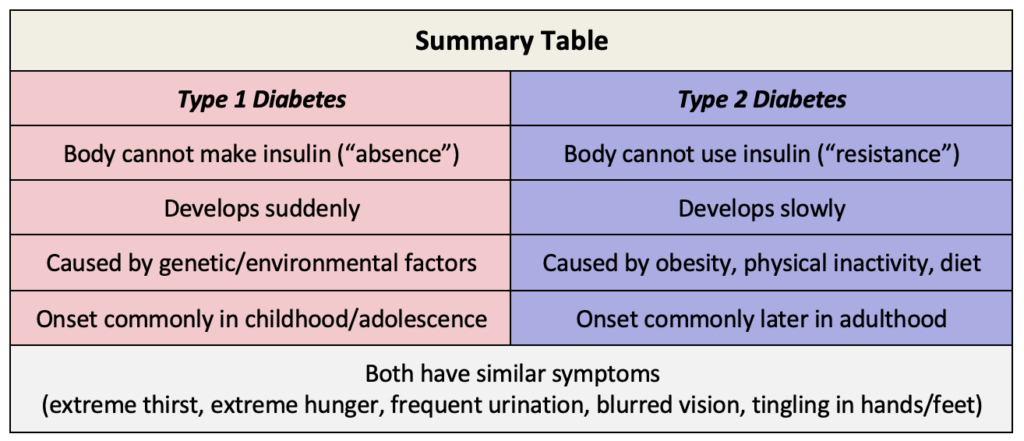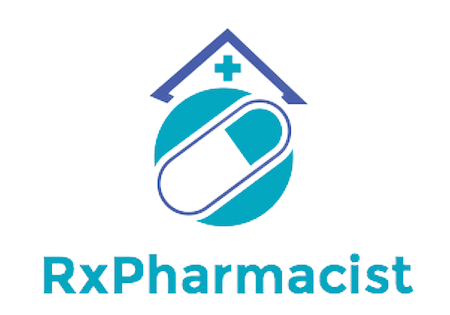Diabetes as a health condition has become so prevalent that the number of cases are reported to be the highest that they have ever been. Per CDC, ~37 million people in the United States have diabetes and 1 in 5 people don’t even know that they have diabetes.1 Moreover, prevalence, is projected to continue to rise in the coming years reaching almost 40 million by 2030.6

That doesn’t mean it’s all doom and gloom. Diabetes can be managed with medication treatment, and even better, prevented or delayed with achievable lifestyle changes. But there are different kinds of diabetes, and despite the name, they’re not all the same nor are they treated in the same manner. Here we’ll focus on type 1 and type 2 diabetes, what makes them different, their symptoms, and their management.
Overview of Diabetes
Diabetes mellitus (DM) is a chronic health condition where your blood glucose, or blood sugar, is too high. Insulin is a hormone produced by the pancreas that helps to control blood glucose by allowing glucose to enter cells and provide the body with energy. By affecting insulin, the blood glucose is also affected. The body is relying on its star player in this role to keep blood glucose in check. Without insulin, blood glucose will rise, leading to health problems over time with key organs such as the heart, kidneys, eyes, and nerves being damaged. There is no cure for diabetes.
Type 1 vs Type 2
Both type 1 diabetes mellitus (T1DM) and type 2 diabetes mellitus (T2DM) have some sort of malfunction issue with insulin, causing it to become deficient.
In T1DM, the body cannot make insulin, stops making it, or it is not making enough of it because the cells in the pancreas that produce insulin are destroyed by the body’s own immune system. The primary cause is believed to be caused by genes and/or environmental causes. It can develop in early childhood/adolescence compared to later in adulthood in people with T2DM.
In T2DM, the body cannot use the insulin despite still making it. Insulin resistance is usually the primary cause of T2DM due to physical inactivity and obesity. Because of this resistance, the body is less able to absorb glucose over time which is why this condition is slow progressing. This contrasts with T1DM where the body is not able to absorb glucose at all and the condition can develop quite suddenly.

Management of Diabetes
There is a difference between how either condition is managed. Diet, exercise, drug therapy, and weight management (weight loss is more associated with T1DM whereas weight gain is more associated with T2DM) play critical roles in controlling blood sugar.

Understanding the difference between Type 1 and Type 2 diabetes is essential for effective management and improved health outcomes. Pharmacists as healthcare professionals can provide education, guidance, and support through helping individuals navigate the challenges of these conditions and work towards better health through a combination of lifestyle changes, medication management, and blood glucose monitoring.
Midrara Kashmari
RxPharmacist Team
References:
- Centers for Disease Control and Prevention. What Is Diabetes? Centers for Disease Control and Prevention. Published April 24, 2023. https://www.cdc.gov/diabetes/basics/diabetes.html.
- CDC. The Facts, Stats, and Impacts of Diabetes. Centers for Disease Control and Prevention. Published 2022. https://www.cdc.gov/diabetes/library/spotlights/diabetes-facts-stats.html.
- Differences Between Type 1 and Type 2 Diabetes – DRC. Diabetes Research Connection. Published July 11, 2016. https://diabetesresearchconnection.org/differences-type-1-type-2-diabetes/?gclid=CjwKCAjwivemBhBhEiwAJxNWN4Hy-wLZ7LNw0yqLEzbHiQ21nhpBRs_0yeq16PHSc69ZPXkZkXhoAhoC5cMQAvD_BwE.
- Type 1 Vs Type 2 Diabetes. DRIF. https://diabetesresearch.org/type-1-vs-type-2-diabetes/.
- NIDDK. Symptoms & Causes of Diabetes | NIDDK. National Institute of Diabetes and Digestive and Kidney Diseases. Published March 2019. https://www.niddk.nih.gov/health-information/diabetes/overview/symptoms-causes
- Lin J, Thompson TJ, Cheng YJ, et al. Projection of the future diabetes burden in the United States through 2060. Population Health Metrics. 2018;16(1). doi:https://doi.org/10.1186/s12963-018-0166-4.

